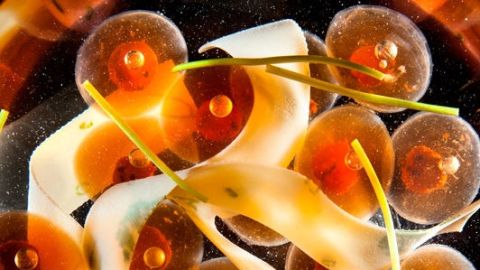These Chemicals Are Good For You (And Yummy)

What’s the Big Idea?
This is not your grandmother’s kitchen. In fact, it much more closely resembles a laboratory, with appliances such as water baths, homogenizers and centrifuges, and ingredients such as hydrocolloids, emulsifiers, and enzymes. This is Nathan Myhrvold’s kitchen, and many of the cooking instruments are his inventions. Myhrvold, the former chief technology officer at Microsoft, has nearly 250 patents either issued or pending under his name and is the founder and CEO of a firm called Intellectual Ventures that is dedicated to creating and investing in inventions.
Along with fellow chefs Chris Young and Maxime Bilet, Myhrvold recently published Modernist Cuisine: The Art and Science of Cooking, a hefty six-volume 2,438-page set that aims to reinvent cooking through “science-inspired techniques for preparing food.” Stay tuned to Big Think this summer as we will be presenting a series of videos featuring Myhrvold’s ideas and insights that might just change your relationship with food. (In particular, I’m looking forward to picking up some July 4th grilling advice from the man who won first place in several categories at the 1991 World Championship of Barbecue.)
But perhaps not all of us are prepared to take on the Iron Chef just yet. First we need to be speaking the same language. Molecular gastronomy is a term that has very much come into vogue following the innovations of people such as Ferran Adrià (aka, “the best chef in the world”) and his restaurant El Bulli in Catalonia, Spain. When overdone, molecular gastronomy runs the risk of transforming the pleasures of the table into a science experiment (Here’s where I like to say “I’d like mine medium-rare, and please hold the foam!”) Myhrvold, understandably, does not like to associate his cuisine with this term. His “modernist cuisine” aims to demonstrate how science and traditional culinary techniques can exist in delicious harmony.
To understand the science of cooking we must understand the basic building blocks we’re working with. As Myhrvold tells Big Think, “Everything in life is made of elements and chemicals. Now, when people say chemicals” they think of some “artificial thing which is going to be bad for me.”
Of course, some chemicals are bad for you. Likewise, many processed foods are unhealthy. As a result, some people might elect to put themselves on the so-called Caveman Diet, as Big Think has detailed here. On the other hand, Myhrvold argues that the common understanding of what is “natural” and what is “processed” is overly simplistic. For instance, muffins are made with baking soda, and there’s “no more processed foods in the world than bread, wine or cheese,” Myhrvold says. In other words, these products are “completely unnatural.”
What’s the Significance?
Myhrvold is not tied to any single ideology when it comes to food preparation. “Sometimes the best way to eat a food is to just eat the raw food or as simply prepared as possible,” he says. And yet, what he prefers to do is “use some technique and some know-how and some creativity.” Some creativity? Judging by his inventions and patents, “parametric recipes” and techniques for creating new flavors and textures, Myhrvold has it in spades.
Watch here:





